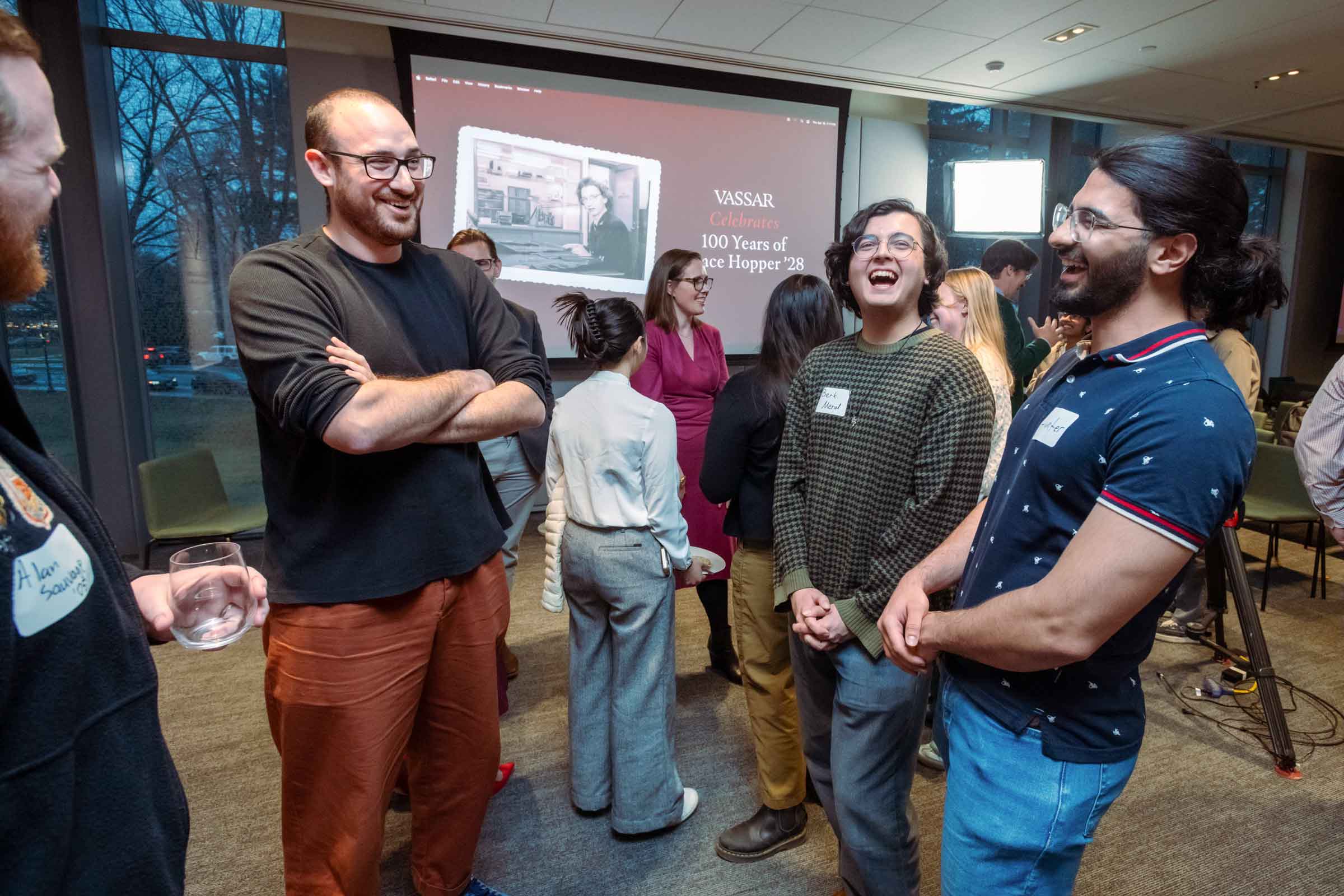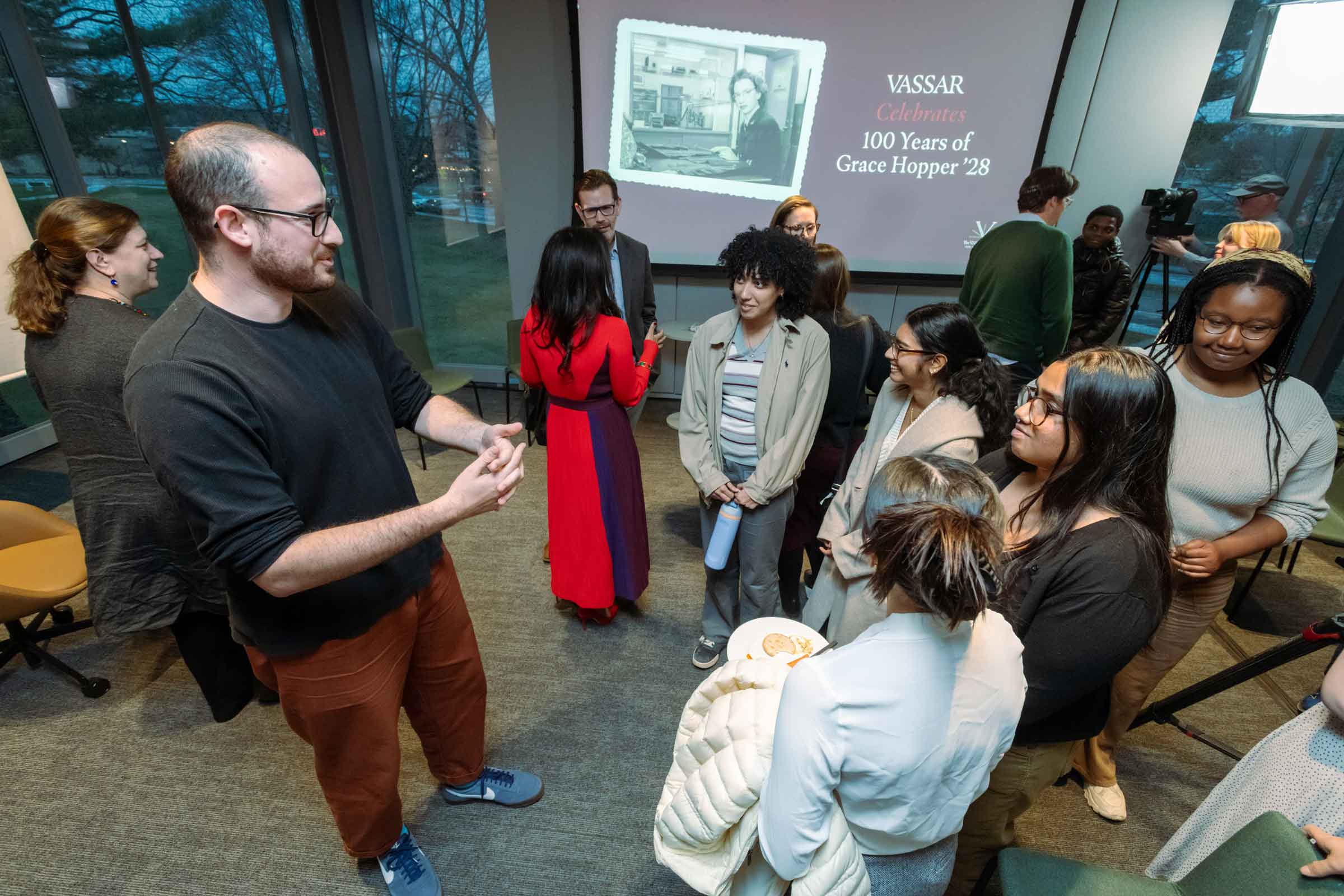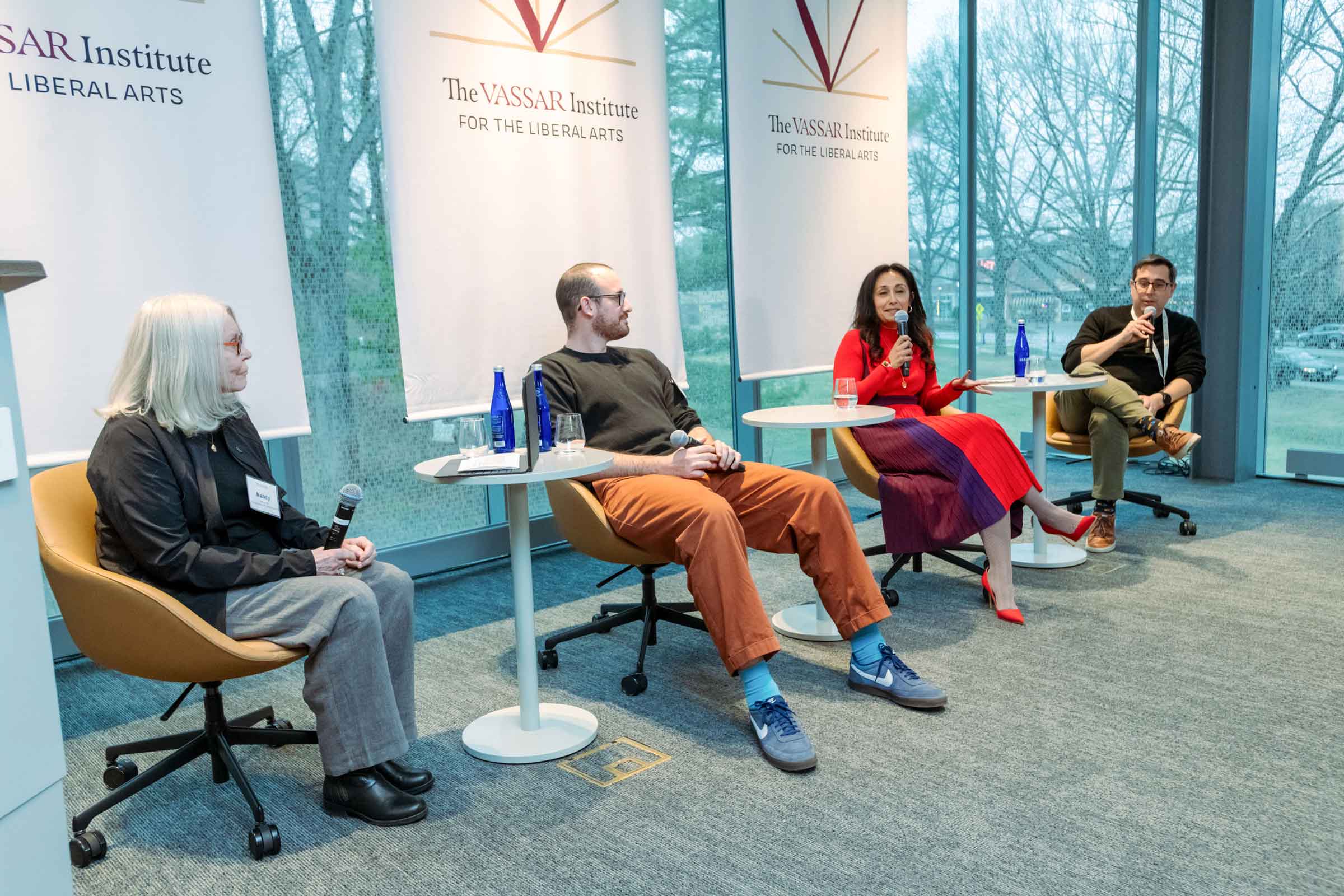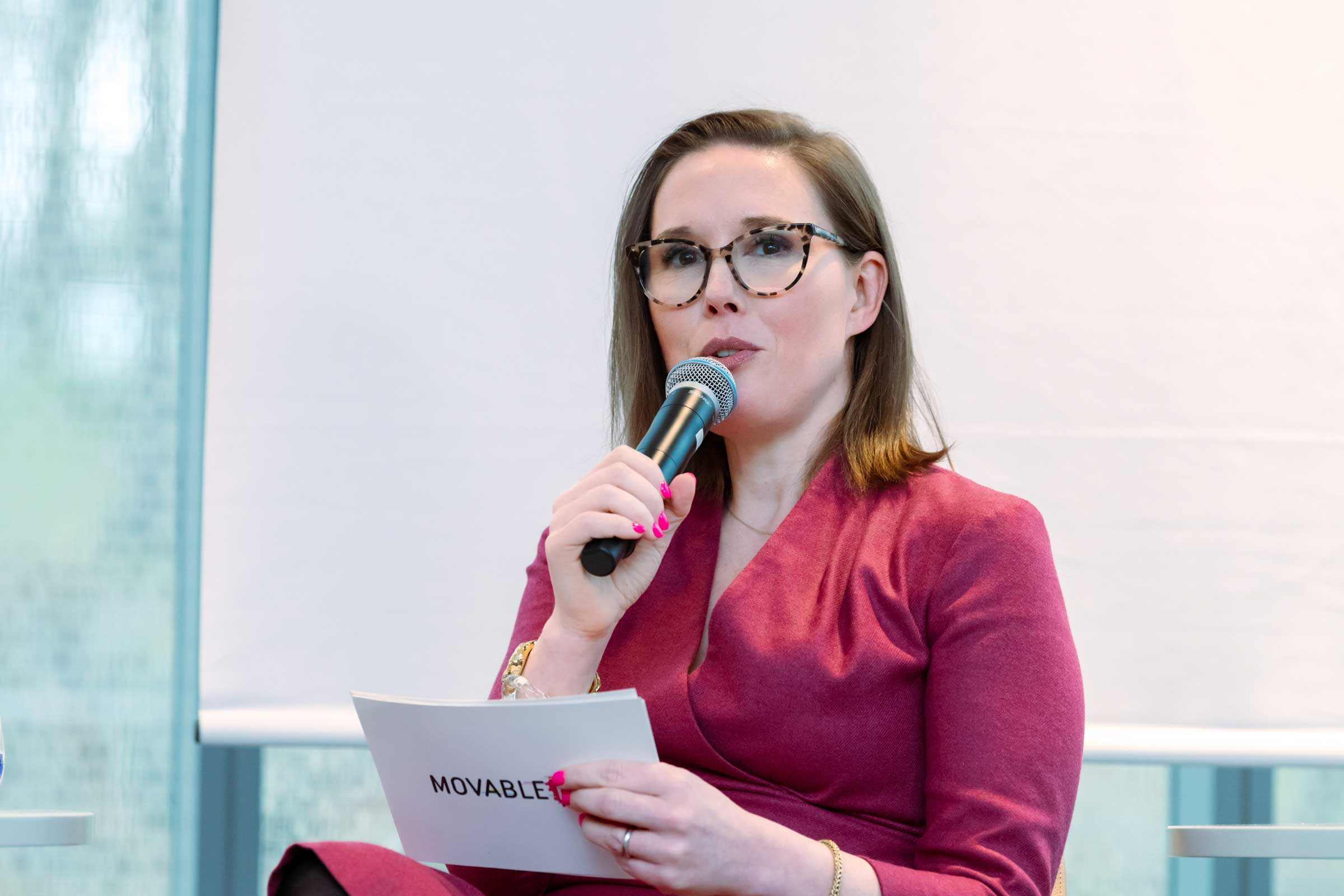Vassar Celebrates 100 Years of Tech Pioneer Grace Hopper ’28
Tech pioneer Grace Hopper ’28 was fond of observing that the most dangerous phrase in the language is, “We’ve always done it that way.”
As Vassar students, faculty, alums, and others in the tech field gathered at The Vassar Institute for the Liberal Arts to celebrate the 100th anniversary of Hopper’s arrival on the Vassar campus, they traded stories about the groundbreaking work she had done to shepherd the world into the modern computer age.

“The seismic impact Grace Hopper had on modern computing cannot be overemphasized,” President Elizabeth Bradley said as she opened the three-hour event. “It’s a joy to be in this space where we have the freedom to think and create—we should make this moment precious.”
As a mathematics major at Vassar who returned to join the mathematics faculty several years later, Hopper joined the Navy after the bombing of Pearl Harbor in 1941. Soon after enlisting, she persuaded her superiors to fund a calculating machine that would help the armed forces gather and store data for the war effort.
Hopper biographer Kurt Beyer opened the event by observing that one of the first things Hopper did in the Navy was to reject the notion of doing things as they’d always been done. “Prior to World War II, all data was analog,” Beyer said. “She broke the notion of single-use function calculators and developed a coding system.”
By 1951, Hopper had developed a theory of programming and the idea of a compiler. With a compiler, a computer could be programmed in a machine-independent, high-level, human language: a universal computing language. And in 1959, the age of technology “took a great leap forward,” Beyer said, “with the development of COBOL (Common Business-Oriented Language), a system that democratized coding that made it simple for everyday users and businesses like Wal-Mart, Smith Barney, American Airlines, and others” to use computers.
Despite her remarkable achievements, Beyer said, Grace Hopper’s contributions to the modern technological landscape have often gone unoticed. “Many people I talk to in Silicon Valley have never heard of Grace,” Beyer said. “But the word is getting out. Vassar, what a gem you had. You should all be very proud.”
Beyer’s talk was followed by a fireside chat between two Vassar alums—Alison Lindland ’00, Chief Marketing Officer at Moveable Ink, a company that uses artificial intelligence and other high-tech tools to help businesses succeed; and Naomi Seligman ’55, who knew Hopper personally. Seligman is a thought leader in the field of computing and technology who has served on 17 corporate boards and currently serves on the Oracle Board of Directors.
Seligman said she had met Hopper when she was working for a consulting firm and was giving a speech at a conference at the Waldorf Astoria Hotel in New York City. “A man I had fired stood up and screamed at me,” Seligman recalled, “and Captain Hopper stood up and said, ‘Let’s take a coffee break.’”
She said Hopper convinced her to resign and start her own business, “and she was a captain in the Navy, so I followed her orders.
“Grace knew her technology,” Seligman continued, “but she was also charismatic. She understood that promoting the use of computers was not just science. She knew we needed the private sector to become involved in computing.”
Lindland noted that Seligman had once referred to Hopper as a genius and asked her to elaborate. “Geniuses are able to see around corners, and Grace could do that,” Seligman replied. “She saw the application of computers [in everyday life] when others did not.”
Asked to comment on the role Vassar’s liberal arts education had played in her own success, Seligman said she had taken several courses that had nothing to do with science or computers that had helped her later in life. “I took a course in revolutionary thought that was all about recognizing patterns,” she said, “and when you learn about technology, your ability to spot patterns is absolutely essential.” (Seligman was a recent guest on the Vassar Podcast Conversations @ the Salt Line.)

The event concluded with a discussion among three Vassar alums moderated by Nancy Ide, Professor Emerita of Computer Science, who had founded Vassar’s Computer Science Department in 1990. Alums on the panel were Peter Leonard ’97, Director of Customer Engineering Excellence for Google Cloud; Reena Mehta ’01, most recently the Senior Vice President of Streaming and Digital Content Strategy at ABC News/Disney; and Matt Foster ’14, an Advanced Senior Game Designer at Insomniac Games in Los Angeles, California.
All three panelists said that following Hopper’s legacy at Vassar had helped them advance in their post-Vassar careers. “I took art history courses here,” Foster said, “and that helped me build the architecture for my games, and my literature courses helped me write them. Writing always helps you in whatever you do.”

Mehta said she, too, had learned how to “write deeply” at Vassar. “It has helped me keep in mind who I’m writing for—who my audience is—and that has enabled me to gain perspectives I needed for the post-Vassar career world.”
When the discussion turned to the impact of artificial intelligence on careers in the future, Leonard said the grounding he received in ethical thought by attending Vassar would enable him to make the right choices working with AI. “We have to decide what’s okay and what’s not okay, and that takes liberal arts skills,” he said.
The event concluded with a CBS TV 60 Minutes video clip in which Hopper reflects on her long career as a tech pioneer. The clip was introduced by Professor of Mathematics and Statistics Emeritus John McCleary, who has written a history of the Mathematics Department; a significant portion of the text is devoted to Hopper’s contributions to Vassar and to the world of science and technology.

As the celebration of Hopper’s life drew to a close, Marc Smith, Professor and Chair of Computer Science, said he had chosen to come to Vassar partially because of Hopper’s legacy. “I’d long known that Grace Hopper attended and taught at Vassar, and it was an honor to have the opportunity to be a part of that. Ever since I’ve been here, I felt we needed a liberal arts event to celebrate her, but this exceeded all my expectations,” Smith said. “I could not be more proud to be following in Grace’s footsteps as a faculty member at Vassar. She is ours.”